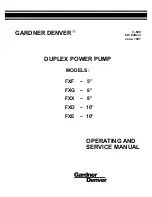
3–600 Page 5
system and discharge system to prevent any flam-
mable, hot, cold or corrosive fluid leakage from dripping
or spraying on any components, flame, sparks, hot ob-
jects or people. Inspect the plungers, packing, gaskets
and seals for fluid leakage frequently and replace all
worn or leaking parts.
Selection of the proper gaskets, seals and stuffing box
packing is even more critical when flammable, hot, cold
or corrosive fluids are being pumped than when other,
inherently less dangerous fluids are used. Contact a
Gardner Denver Machinery service representative for
assistance in selecting the proper gaskets, seals and
packing before beginning operation.
Since some packing weepage into the cradle area is in-
evitable, the drain at the bottom of the cradle must be
connected to a drain line which conducts the fluid leak-
age to a collection container located in a protected
area. The entire drain system and container must be
constructed of materials resistant to attack from the
pumped fluid or from explosion or fire of the pumped
fluid. Heavy duty cradle covers must be securely
fastened in the proper position on the pump at all
times when the pump is operating. If the pumped
fluid releases harmful, explosive or flammable va-
pors the covers must be vented to conduct the
fumes away from the pump unit to a nonhazardous
area.
Before beginning pumping operations or starting the
pump power source (whether an engine or electric mo-
tor) check the atmosphere all around the pumping site
for the presence of flammable or explosive vapors. Do
not begin operation and stop ongoing operation if flam-
mable or explosive vapors are detected. Hot surfaces,
sparks, electric current or engine exhaust could ignite
flammable or explosive vapors. Each engine used as
a power source on pumping units where flammable or
explosive vapors could form should be equipped with
an air inlet shut–off. If flammable or explosive vapors
are present in the pumping site atmosphere, an engine
could continue to run on these vapors even after the en-
gine fuel line is shut–off if an air inlet shut–off is not
used.
In addition, on pumping units used where flammable or
explosive vapors could form, all electric motors used as
power sources must be of explosion proof construction
and all electrical components and wiring must meet the
current National Electrical Code for explosive atmosp-
heres.
These precautions must be taken to avoid possible per-
sonal injury, death and/or equipment damage from ex-
plosion, fire or burns.
HIGH PRESSURE LIQUID JETTING, BLASTING
AND CLEANING
Extreme caution must be exercised if
any type of wand, gun, nozzle or any
other pressure and flow directing de-
vice is attached to the pump dis-
charge system for use in jetting,
blasting, cleaning, etc. This type of
equipment must be used with utmost
care by trained, experienced opera-
tors. High pressure fluid streams can
either by direct contact or by propel-
ling loose objects, cause serious per-
sonal injury or death to the operators
and/or other persons.
Pressure or flow directing devices often receive pres-
surized flow through flexible hoses, which can burst if
they are kinked, cut, abraded or are otherwise worn,
damaged or pressured above their rated capacity. Pro-
tect the hose and connections from damage by people,
objects and vehicles. A broken, cut or otherwise burst
hose can release pressurized fluid which may cause
personal injury, death and/or equipment damage.
High pressure fluid from hand held or hand directed
pressure and flow directing devices may overpower an
operator’s ability to control or direct the device, which
could lead to personal injury, death and/or equipment
damage. The operator must brace against the back-
ward thrust of a hand held device. In addition, a safety
harness or safety net must be used when working in an
area where the operator could be injured in a fall. Stand
to the side of any tubing or container being sprayed to
avoid back spray and never operate a hand held device
above shoulder level.
Never direct the pressurized fluid stream at yourself or
any other person, control valves, the pump, pump
drive, suction or discharge systems. The pressurized
stream can cause serious personal injury or death and
can also change valve or control settings which could
dangerously increase the delivery pressure to the pres-
sure and flow directing device.
When operating a pressure and flow directing device,
use only equipment which automatically shuts off flow
when an operator releases hand or foot pressure on the
pressurized flow trigger control to prevent injury if the
operator is overpowered or becomes disabled.
Check to insure this automatic shut–off equipment is
operating properly before every use and never circum-


























